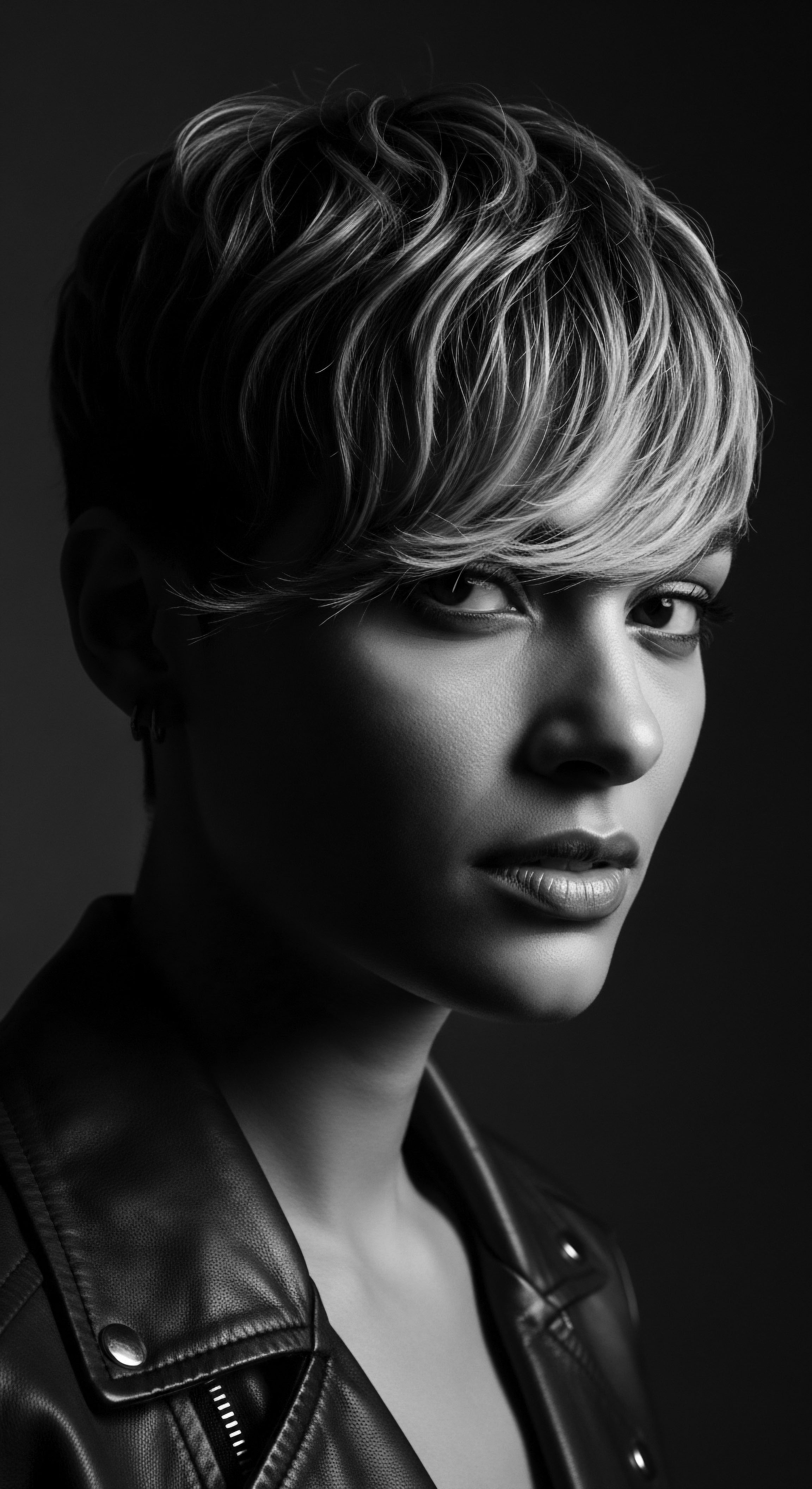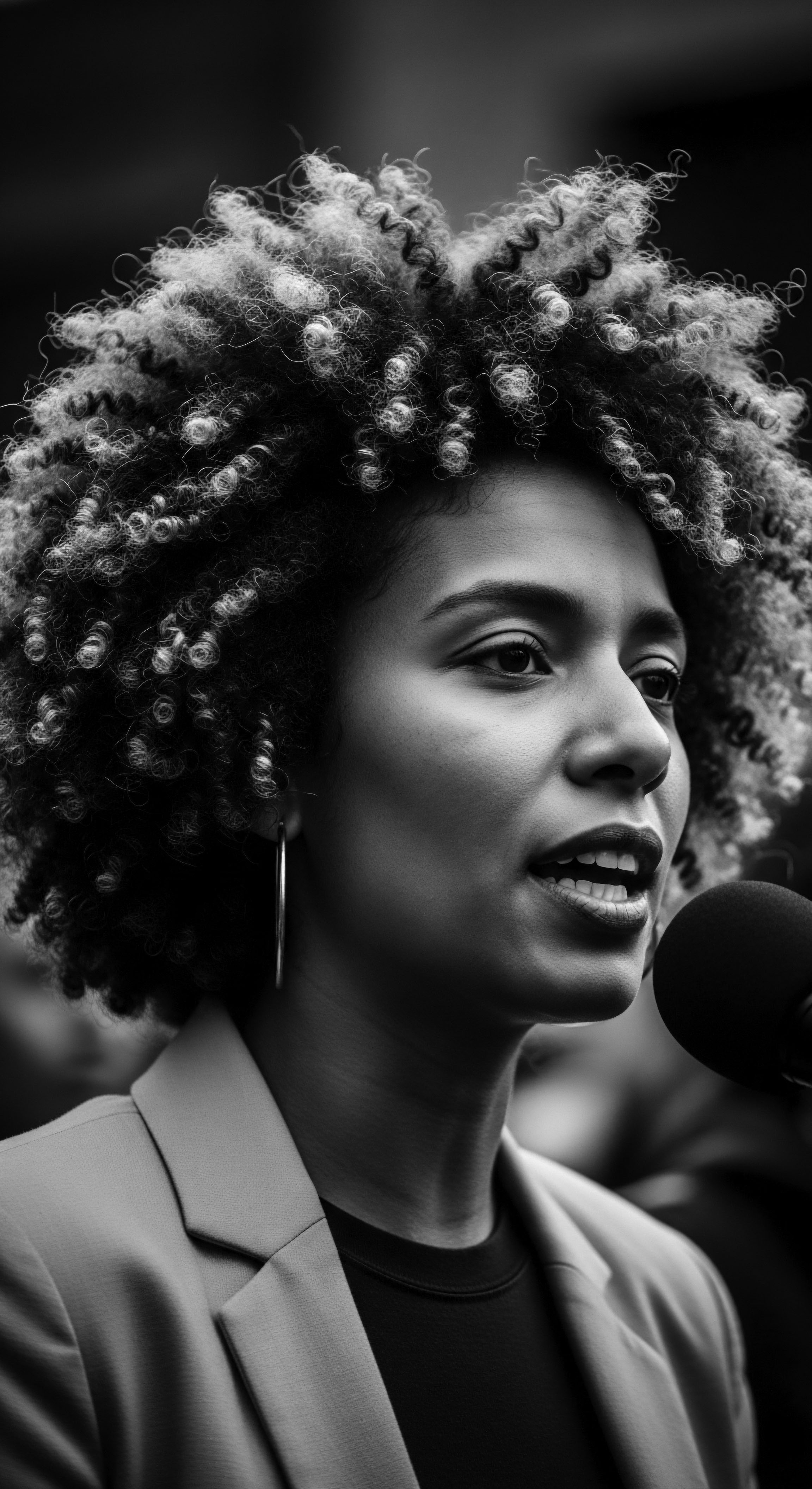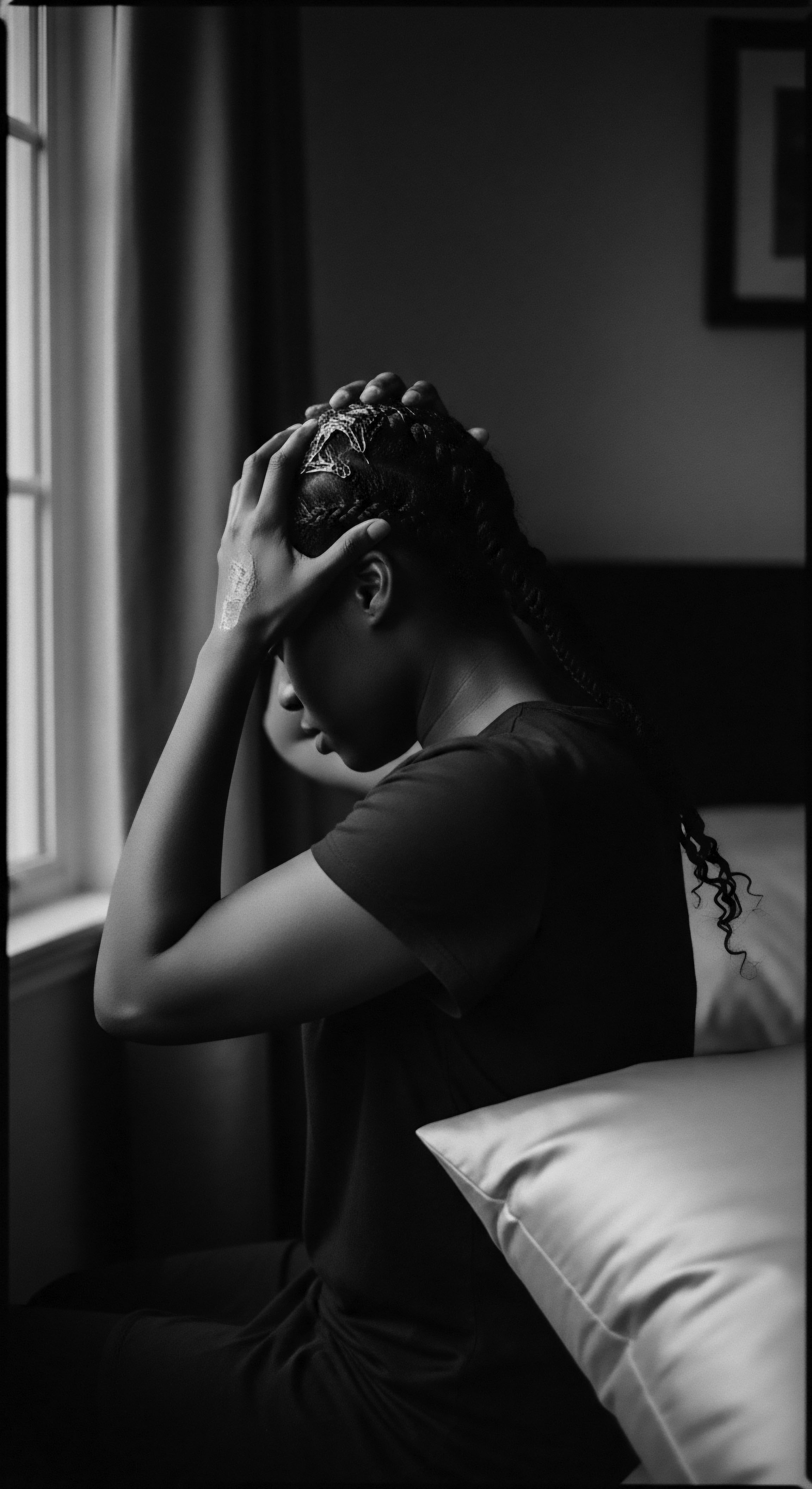
Roots
There exists a profound, often unspoken, language within the very spirals and kinks of textured hair—a language of resilience, of care, and of unbroken lineage. For those who carry the heritage of coils and curls, a nightly ritual often unfolds, one that involves a simple yet deeply resonant garment ❉ the hair bonnet. This isn’t merely an accessory for slumber; it is a repository of generational wisdom, a silent guardian against friction and dehydration, and a living symbol of an enduring connection to ancestral practices. To understand the bonnet, we must first hear the whispers from the genesis of textured hair itself, tracing its path from elemental biology to the rich tapestries of human experience, all steeped in the memory of heritage.

What Biological Attributes of Textured Hair Benefit from Night Protection?
Textured hair, particularly that with tighter coils, possesses a unique anatomical structure. Each strand emerges from a curved follicle, giving it an elliptical shape rather than the round cross-section typical of straight hair. This elliptical form, combined with the multiple twists and turns along the hair shaft, inherently creates more points of contact for friction. This structural reality, deeply rooted in our biological make-up, means textured hair is often more susceptible to breakage, dryness, and tangling than its straighter counterparts.
Historically, this innate fragility, a biological gift of adaptation to intense solar radiation and warmth retention for the scalp in ancestral climates, also presented a challenge in daily preservation. The very architecture of coiled hair, a marvel of natural design, necessitated innovative approaches to its long-term health and maintenance, paving the way for protective measures like bonnets.

Echoes from the Source Hair Coverings in Ancient Africa
Long before the painful rupture of the transatlantic slave trade, head coverings held immense social, spiritual, and functional significance across diverse African communities. These were not uniform practices; rather, they varied by region, tribe, and individual status. For example, in West Africa, the Yoruba and Igbo women would adorn elaborate headwraps, known as Geles, for celebrations, their complexity signifying status. Ghanaian women wore Dukus, and in South Africa, head coverings were called Doeks.
These wraps served multiple purposes ❉ protection from the elements, especially the scorching sun, and a means to convey wealth, marital status, or even emotional states. They were expressions of identity, artistry, and communal belonging. When individuals were taken from their homelands, often having their heads shaved as a deliberate act of dehumanization and cultural erasure, they carried with them the memory of these practices, a silent seed of resilience in a strange, brutal new world.
The history of bonnets is inextricably linked to the protective instincts and cultural assertions of those with textured hair.
The transition from elaborate African headwraps to the more utilitarian, yet equally significant, hair bonnet in the diaspora reflects a harsh adaptation. Forced into servitude, with scant resources and little time for traditional hair care, enslaved African women found rudimentary means to safeguard their hair. Scraps of fabric, handkerchiefs, or cotton rags became their first bonnets, improvised tools to prevent tangles, frizz, and breakage amidst grueling labor and unsanitary conditions. These coverings were not merely about neatness; they were symbols of survival, dignity, and a tenacious hold on a heritage under assault.
| Period Ancient African Kingdoms |
| Purpose and Cultural Significance Status, tribal identity, spiritual connection, protection from sun and dust. |
| Common Materials and Styles Locally woven textiles, elaborate wraps (gele, duku, doek), decorated with cowrie shells, beads. |
| Period Enslavement Era |
| Purpose and Cultural Significance Protection from harsh conditions, concealment of unkempt hair, marker of forced servitude, quiet acts of resistance. |
| Common Materials and Styles Scraps of fabric, handkerchiefs, cotton rags, simple head-ties. |
| Period Post-Emancipation to Mid-20th Century |
| Purpose and Cultural Significance Practicality for labor, evolving into fashion statements, nighttime hair preservation. |
| Common Materials and Styles Cotton, silk, satin, often simple caps evolving into more decorative styles. |
| Period The journey of hair coverings mirrors the journey of Black people ❉ from symbols of rich heritage, through oppression, to tools of resilience and identity reclamation. |
Laws were even enacted in certain areas of the South, such as the 1784 “Edict of Good Government” in Louisiana, requiring Black women to wear their hair bound in a kerchief or a “tignon.” What was intended as a mark of subservience, however, was defiantly transformed into an act of sartorial rebellion. Black women adorned these mandated coverings with beautiful fabrics, feathers, and jewels, transforming symbols of oppression into statements of vibrant identity and aesthetic defiance.

Ritual
The bonnets’ presence in the daily lives of Black women, especially as night settled, became a deeply embedded ritual, a testament to practical needs interwoven with self-preservation and a silent assertion of worth. This garment, a simple cap often of soft material, became a nocturnal sanctuary, a quiet act of care against the forces of friction and dryness that could easily compromise textured hair. The meticulous practice of securing hair within a bonnet before rest speaks to a collective understanding passed down through generations—a wisdom concerning hair’s vulnerability and the means to sustain its vitality.

How Have Bonnets Sustained Traditional Hair Practices?
For individuals with coiled and kinky hair, the nightly ritual of covering one’s head serves a profound purpose. The innate structural characteristics of textured hair, with its propensity to tangle and lose moisture rapidly, render it particularly susceptible to damage from friction against common bedding materials. Cotton pillowcases, with their absorbent and relatively rough surfaces, can strip natural oils from the hair and create micro-abrasions along the delicate cuticle, leading to breakage and frizz. The bonnet acts as a crucial barrier, providing a smooth, non-absorbent surface, often made of silk or satin, that permits hair to glide freely, thereby preserving its moisture and structural integrity.
This protective function extends far beyond mere cosmetic benefits; it directly impacts the longevity and health of various protective styles. Braids, twists, locs, and cornrows, styles deeply rooted in African ancestry and cultural expression, require significant time and effort to create. Bonnets safeguard these intricate arrangements, preventing them from unraveling, frizzing, or accumulating lint overnight. This preservation allows individuals to extend the wear of these styles, minimizing the frequency of manipulation and thus reducing potential strain on the hair and scalp.
The bonnet transmutes a simple fabric into a shield, safeguarding styles and preserving hair’s inherent moisture.
One powerful historical example of this dedication to hair preservation, even amidst unimaginable adversity, emerges from the testimonies of enslaved people. Accounts from the Federal Writers’ Project, which collected narratives of formerly enslaved individuals, speak to the ingenuity and resourcefulness employed in hair care. For instance, “Aunt Tildy” Collins, whose narrative is recorded in the collection, describes her mother and grandmother preparing her hair for Sunday school, using methods like threading with fabric or cotton, and plaiting to achieve defined curls. While specific mention of bonnets for night is less common in these direct accounts compared to general head coverings, the underlying imperative for protection and maintenance of these painstakingly prepared styles was undeniable.
The use of head wraps or bandanas to shield hair from the sun, absorb sweat, keep styles intact, and even “train” hair growth was a widespread practice. These coverings, whether for day or night, served a utilitarian role in keeping hair tidy and protected in conditions where proper care was severely limited.
- Coil Preservation ❉ The smooth interior of a bonnet helps to maintain the natural curl pattern of textured hair, preventing it from flattening or losing definition during sleep.
- Moisture Retention ❉ Silk and satin materials do not absorb hair’s natural oils and applied products, keeping strands hydrated and less prone to dryness and breakage.
- Style Longevity ❉ Bonnets protect various hair configurations, including braids, twists, and straightened styles, extending their freshness and reducing the need for frequent restyling.
- Friction Mitigation ❉ The slick surface prevents rubbing against rough fabrics like cotton pillowcases, which can lead to frizz, tangles, and split ends.

What Cultural Meanings Adorn the Modern Bonnet?
Beyond its practical benefits, the modern bonnet continues to hold significant cultural meaning. For many, wearing a bonnet is an act of self-care and a connection to a legacy of hair resilience. It represents a conscious decision to nurture one’s natural hair, a silent rejection of historical beauty standards that often devalued textured hair. The bonnet, therefore, embodies a quiet pride, a daily affirmation of one’s heritage and beauty.
The symbolism of head coverings for Black women has shifted through centuries. Initially, in many African societies, hair styling itself was a profound form of communication, denoting status, age, and identity. The forced shaving of heads during enslavement was a deliberate act to strip this identity.
Yet, even under oppressive laws like the Tignon Laws in 18th-century Louisiana, which compelled free women of color to cover their hair, these women transformed the mandated kerchiefs into elaborate, fashion-forward statements of resistance, using luxurious fabrics and artistic wraps. This historical context deeply informs the contemporary bonnet, recognizing its origins in forced concealment and its evolution into a chosen emblem of personal and communal identity.

Relay
The journey of the hair bonnet, from its rudimentary origins as a tool of necessity and subtle defiance to its current standing as a celebrated accessory, charts a course of persistent cultural relay. This trajectory is not linear, but rather a spiraling narrative, continually adapting, yet steadfastly rooted in the ancestral wisdom of hair care. The bonnet, in its contemporary manifestations, carries the echoes of countless generations, each contributing to its enduring significance as both a practical garment and a powerful symbol of heritage.

Beyond Protection What Deeper Significance Do Bonnets Hold for Identity?
The bonnet’s function extends beyond mere physical protection; it guards a spiritual and cultural space. In the Black diaspora, hair has always been a battleground, a site of identity contested and reclaimed. Laws and societal pressures sought to regulate and demean textured hair, forcing assimilation into Eurocentric beauty ideals.
The bonnet, even when worn privately, offered a respite from these external judgments, a space where natural hair could exist unburdened. When worn publicly, particularly in the modern era, it became a quiet, yet undeniable, declaration of self-acceptance and cultural pride.
This subtle, yet potent, defiance is not new. During enslavement, slave mistresses often expressed disgust at the vibrant headwraps worn by enslaved Black women, which were seen as a threat to the established social order. These women, despite their subjugated status, found ways to express individuality through their head coverings, turning a mark of supposed inferiority into a canvas for self-expression and communal identity. In some parts of Central America, Black women even used the folds of their headscarves to communicate coded messages, unseen and unheard by their enslavers, transforming a tool of control into a secret language of resistance.
The bonnet, a seemingly simple garment, holds layers of meaning, from private self-care to public defiance.
The continued presence of the bonnet in modern Black culture, from everyday routines to its appearances in media and fashion, speaks to its resilience as a cultural icon. It embodies a legacy of survival, a celebration of unique hair textures, and a collective commitment to self-care passed down through familial and communal ties. This continuity links contemporary wearers to the resourcefulness and spirit of their ancestors, creating a powerful, living connection to heritage.

What Modern Scientific Insights Align with Ancestral Bonnet Practices?
Modern hair science has increasingly affirmed the traditional wisdom embedded in the use of hair bonnets. The smooth, low-friction surfaces of silk and satin are now scientifically recognized for their ability to prevent mechanical damage to hair. Research indicates that silk’s smooth texture minimizes friction between hair strands and bedding, thereby reducing tangles, breakage, and frizz. Unlike cotton, which absorbs moisture from hair, silk and satin allow hair to retain its natural oils and hydration, promoting overall hair health and elasticity.
This scientific validation underscores the efficacy of a practice honed through centuries of practical application. The ancestral knowledge, born of observation and adaptation to the specific needs of textured hair, finds resonance in contemporary dermatological and haircare understanding. The benefits extend to preserving various hair manipulations, from intricately styled braids to straightened looks, preventing the need for frequent restyling and the associated mechanical or heat stress.
- Reduced Mechanical Stress ❉ Scientific studies confirm that silk and satin minimize friction, preventing breakage, split ends, and damage to the hair cuticle during sleep.
- Optimal Hydration Levels ❉ The non-absorbent properties of these materials ensure that hair’s natural oils and any applied conditioning products remain on the hair shaft, contributing to moisture retention.
- Scalp Health Support ❉ By reducing friction and maintaining a consistent moisture environment, bonnets can contribute to a healthier scalp, potentially alleviating issues like dryness or irritation.
| Material Cotton Rags/Handkerchiefs |
| Historical Context and Usage Used during enslavement for basic protection and concealment due to availability. |
| Modern Scientific Understanding of Benefits Offered basic physical barrier, but could absorb moisture and cause friction. |
| Material Silk |
| Historical Context and Usage Historical use in some African and Caribbean cultures for hair protection due to its smooth texture. |
| Modern Scientific Understanding of Benefits Natural protein fiber, hypoallergenic, excellent for reducing friction, preventing breakage, and retaining hair's natural moisture. |
| Material Satin |
| Historical Context and Usage Gained popularity later as a more accessible alternative to silk, especially in the 20th century. |
| Modern Scientific Understanding of Benefits A weave pattern that creates a smooth surface, providing similar friction-reducing benefits to silk, though material content varies. |
| Material The selection of bonnet materials reflects both historical accessibility and an evolving understanding of optimal hair protection for textured strands. |

Reflection
The humble hair bonnet stands as a testament to continuity and deep seated knowledge, a powerful conduit between the past and the present. It represents more than a simple act of night-time hair care; it embodies a living archive of textured hair heritage. From the ingenuity of enslaved ancestors who found ways to protect their crowns amidst profound adversity, to the modern scientist who deciphers the precise benefits of silk’s smooth glide, the bonnet’s story is a profound meditation on the enduring wisdom of generations.
It is a symbol of self-preservation, a whisper of defiance, and a loud declaration of cultural pride, woven into the fabric of daily life. As we cover our coils and kinks, we connect with a legacy of care, resistance, and beauty that continues to thrive, a soulful strand in the unbound helix of our shared history.

References
- Byrd, A. D. & Tharps, L. D. (2014). Hair Story ❉ Untangling the Roots of Black Hair in America. St. Martin’s Press.
- Caffrey, C. (2023). Afro-textured hair. EBSCO Research Starters.
- Collins, Aunt T. (n.d.). Slave Narratives from the Federal Writers’ Project. In Library of Congress. Born in Slavery ❉ Slave Narratives from the Federal Writers’ Project.
- Donahoo, K. L. (2019). Black Hair and the Civil Rights Movement ❉ We Shall Not Be Moved. University Press of Mississippi.
- Gabbara, A. (2017). African American Dress and Adornment ❉ A Cultural Perspective. Fairchild Books.
- Griebel, H. B. (1994). The African American Woman’s Headwrap ❉ Unwinding the Symbols. Art, Design, and Visual Thinking.
- Katz-Hyman, M. B. & Rice, K. M. (2011). Gather Ye All the African Americans ❉ The Black Family in Maryland, 1634-1820. Johns Hopkins University Press.
- Kynard, C. (2013). Wrapping Our Heads ❉ Archiving Black Women’s Style Politics. Education, Liberation & Black Radical Traditions for the 21st Century.
- Mercer, K. (2000). Welcome to the Jungle ❉ New Positions in Black Cultural Studies. Routledge.
- Moore, A. (2014). Black Hair ❉ A Cultural History. Berg.
- Okazawa-Rey, M. Robinson, T. & Ward, J. V. (1987). Black Women, Racism, and Psychiatry. Haworth Press.
- Rodriguez, T. D. (2023). Black Hair ❉ Art, Culture, and Politics. Duke University Press.
- Thompson, S. (2009). Hair Story ❉ Madame C.J. Walker’s Magnificent Empire. Penguin Books.
